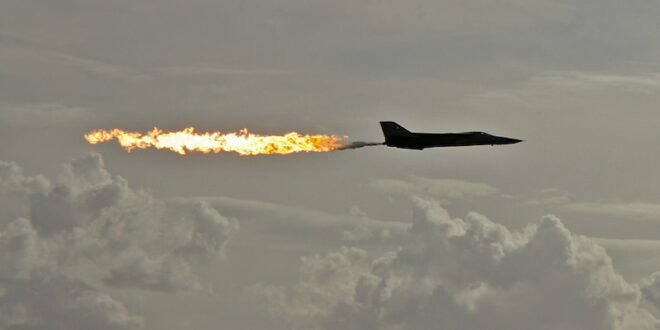The global pandemic was not completely catastrophic in its effects. It led to the cancellation, and postponement, of wasteful projects and events. It spared public money. But as the pandemic slides into the shadow of policymaking, bad habits have returned. The profligates are here to stay.
One such habit is the Avalon air show, a celebration of aeronautical militarism in the southern hemisphere best done without. In 2021, the organisers announced with regret that the event would be cancelled due to COVID-19 restrictions and uncertainty. Last October, however, organisers promised a return to form in 2023. Those with tickets “can look forward to a whole new program with jaw-dropping aerial displays, a refreshed food and beverage offering, and live entertainment.”
Also known as the Australian International Airshow and Aerospace and Defence Exposition, Avalon2023 promises to “showcase” much in the “dynamic world of aviation, aerospace and space, new materials, fuels and ways of flying”.
The program features both a specialist dimension and complimentary conferences “open to any accredited Trade Visitor”. The specialist aspect will feature presentations from, among others, the Royal Australian Air Force, Australian International Aerospace Congress, Australian Association for Unscrewed Systems (AAUS), Australian Industry Defence Network (AIDN), and the Australian Airports Association.
With this military bonanza unfolding on February 28, the Australian Defence Minister, Richard “Call me Deputy Prime Minister” Marles, has tooted his justifications for more hardware, more military merchandise and more engagement with the defence industry. His address to the Avalon 2023 Defence and Industry Dinner revealed a boyish credulity typical in so many who lead that portfolio. The boys-with-toys credo becomes all seducing. Air forces, he noted, “are the coolest part of any military.” Trying to amuse, he called Top Gun Maverick “an important and insightful documentary”.
With that treacly tribute out of the way, Marles could get down to the business of frightening Australians and delighting the military industrial mandarins. Australia faced “the most challenging and complex set of strategic circumstances we’ve seen since the Second World War.” The “global rules-based order” had been placed “under immense pressure”, largely due to the Russian invasion of Ukraine. “The post-Cold War era – a period of democratic expansion and unprecedented integration of global trade and investment – is now over.”
The scriptwriter had evidently gone to sleep in drafting such words. The post-Cold War era was streaked by brutal invasions and interventions (Iraq and Libya, to name but two instances), supposedly by the rules-abiding types in Washington, London and Canberra. The Russian invasion did feature the imposition of will by a larger state on a smaller neighbour using “power and might”, but the US-led invasion that kicked the hornet’s nest of sectarian violence in 2003 came from the same stable of thought.
The speech then follows a familiar pattern. First, call out the Russians. Then highlight the Oriental Armed Scourge to the North. “In the Indo-Pacific, China is driving the largest conventional military build-up we’ve seen anywhere in the world since the Second World War. And much of this build-up is opaque.”
Australia’s security, assured by its remote location and geography, could no longer be taken seriously. “Today we face a range of threats – including longer-range missiles and hypersonics and cyber-attacks – which render our geographic advantages far less relevant.”
The enemy could do damage from afar, causing harm “without ever having to enter our territorial waters or our air space.” It was therefore important to place Australian defence upon the footing of “being able to hold any potential adversaries at risk much further from our shores.”
This was a rather devious way of laying the ground for more cash and larger budgets, ignoring the clear point that Australia has no truly mortal enemies, but wishes to make them as Washington’s obedient deputy.
One particular product is meant to take centre stage. The Australian Defence Force is lagging in the department of murderous drone technology. One promises to be unveiled at Avalon. As reported by the national broadcaster, “The unscrewed air system has been developed by BAE Systems Australia and is designed to be stored in shipping containers.” The device is allegedly capable of carrying a lethal payload in excess of 100 kilograms.
Australia’s Chief of Air Force, Air Marshal Robert Chipman, has made no secret of his desire for low-cost killer drones. “We’ve seen a proliferation of low-cost drones and loitering munitions delivering both ISR [intelligence, surveillance and reconnaissance] and fires to great effect,” he told a Melbourne audience filled with foreign air force chiefs and senior officials, “they don’t replace the roles of contemporary combat aircraft, but they might serve as a useful complement.”
With that in mind, the RAAF was “considering the potential of low-cost drones that bring mass to our air combat system, and we’re considering what new measures are necessary to defend against them.” Such views thrilled the war mongering offices at The Australian, which expressed satisfaction that Australian military policy was finally “moving in the right direction.”
Chapman has been particularly busy in the leadup to the Avalon airshow, walking the tightrope of defence propaganda. Self-praise and capability must be balanced against a fear of achievement on the part of an adversary.
In an interview with the Australian Financial Review last week, the Air Marshal revealed that the RAAF had also joined the hysteria about targeting high altitude surveillance balloons. He also defended the merits of the F-35 fighter jet, praising their pilots as having “retained an edge over drones or other unscrewed platforms despite advances in technology.”
China, however, was causing jitters in the area of hypersonic missiles, capable of delivering a warhead at five times the speed of sound with extreme manoeuvrability. “I think China is in front when it comes to hypersonics […] and that is something we are actively working to address.” Thank goodness, then, for the Avalon Air Show, even if the organisers were not sagacious enough to invite both Chinese and Russian manufacturers.
 Eurasia Press & News
Eurasia Press & News



